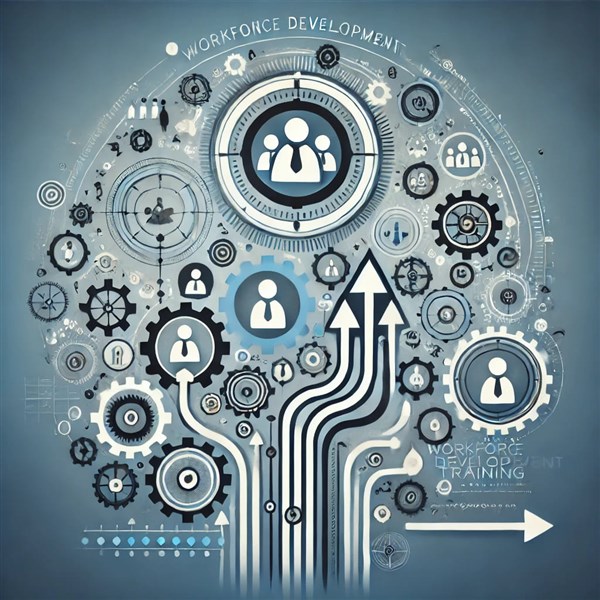We're open through the holidays to support your upskilling goals — Which training do you want to book?
We're open through the holidays to support your upskilling goals — Which training do you want to book?
Unable to find what you're searching for?
We're here to help you find it
In today’s fast-paced, ever-evolving job market, employers and employees alike are under constant pressure to stay ahead of the curve. From digital transformation to shifting workplace dynamics, the skills once considered “nice to have” are now mission-critical.
That’s where workforce development training steps in.
More than just job-specific education, workforce development programs focus on equipping individuals with a diverse, adaptable skillset that’s relevant across industries and roles. These programs aim to prepare people for long-term career growth, increased productivity, and meaningful contributions to the modern economy.
But what exactly do these training programs teach?
In this blog, we’ll break down the top skills taught in workforce development training programs, why they matter, and how they empower both individuals and organizations to thrive in the workplace of today—and tomorrow.
What’s Taught:
Why It Matters:
Effective communication is the cornerstone of workplace success. Whether working on a team project, presenting ideas, or resolving conflict, being able to express oneself clearly and respectfully is essential. Workforce development training ensures participants learn to listen actively, speak confidently, and interact professionally.
What’s Taught:
Why It Matters:
In an era of rapid change, the ability to think critically and solve problems creatively is invaluable. These skills allow employees to handle complex tasks, contribute to innovation, and adapt to new challenges. Training fosters a mindset of curiosity, resilience, and continuous improvement.
What’s Taught:
Why It Matters:
Whether in-person or remote, most jobs today rely on digital tools and platforms. Workforce development programs help bridge the digital divide by teaching participants to navigate, evaluate, and create information using digital technologies—a core requirement in virtually all modern roles.
What’s Taught:
Why It Matters:
No one works in a vacuum. Being a strong team player means understanding how to contribute meaningfully, respect others’ perspectives, and move projects forward together. Workforce development training builds the emotional and social skills needed for cohesive team performance.
What’s Taught:
Why It Matters:
Increased responsibilities, remote work, and overlapping deadlines make effective time management a non-negotiable skill. Training in this area boosts productivity and reduces stress, empowering employees to deliver consistently and efficiently.
What’s Taught:
Why It Matters:
In today’s volatile job market, employees need to adapt quickly and remain emotionally steady during change. Workforce development training helps participants develop mental flexibility and the emotional tools to face challenges with confidence.
What’s Taught:
Why It Matters:
While not always included in traditional job training, financial literacy helps individuals make better life decisions, reducing stress and increasing stability. Employees with this knowledge tend to be more focused, motivated, and financially secure.
What’s Taught:
Why It Matters:
In any customer-facing role, exceptional service is a competitive advantage. Workforce development training ensures employees understand how to build trust, manage emotions, and deliver experiences that keep customers coming back.
What’s Taught:
Why It Matters:
Especially for early-career professionals, training provides a realistic introduction to workplace culture. It ensures new hires are prepared to succeed from day one by instilling confidence and a professional mindset.
What’s Taught:
Why It Matters:
Even at the frontline level, cultivating leadership prepares employees to take on more responsibility. This pipeline approach to leadership development ensures the organization is ready for growth and succession planning.
These programs benefit a wide range of participants, including:
|
Benefit Area |
Outcome |
|---|---|
|
Employee Productivity |
Better efficiency, time management, and accountability |
|
Retention and Engagement |
Increased job satisfaction and loyalty |
|
Adaptability |
Readiness for technological and market shifts |
|
Customer Satisfaction |
Improved service delivery through soft skills and empathy |
|
Workforce Agility |
Flexible, future-ready teams that can adapt to new challenges |
🧭 Final Thoughts
In an age where automation, digitization, and demographic shifts are reshaping the world of work, workforce development training isn’t just a value-add — it’s a necessity. It strengthens the foundation of individuals, teams, and entire organizations, creating a ripple effect that drives economic growth and long-term sustainability.
By teaching both hard and soft skills—ranging from tech tools to time management and communication—these programs prepare people not just for a job, but for a career.
✅ Final Takeaway:
Whether you’re an employer seeking a more capable team, a learner aiming to future-proof your career, or a policymaker driving economic development, workforce development training is one of the most impactful investments you can make. It builds confidence, cultivates capability, and opens the door to meaningful, modern work.
In conclusion, workforce development training programs are crucial for equipping employees with the necessary skills to drive business growth. Companies such as Koenig Solutions provide comprehensive training in these areas, ensuring your workforce is ready for the challenges of the digital age.

Aarav Goel has top education industry knowledge with 4 years of experience. Being a passionate blogger also does blogging on the technology niche.










